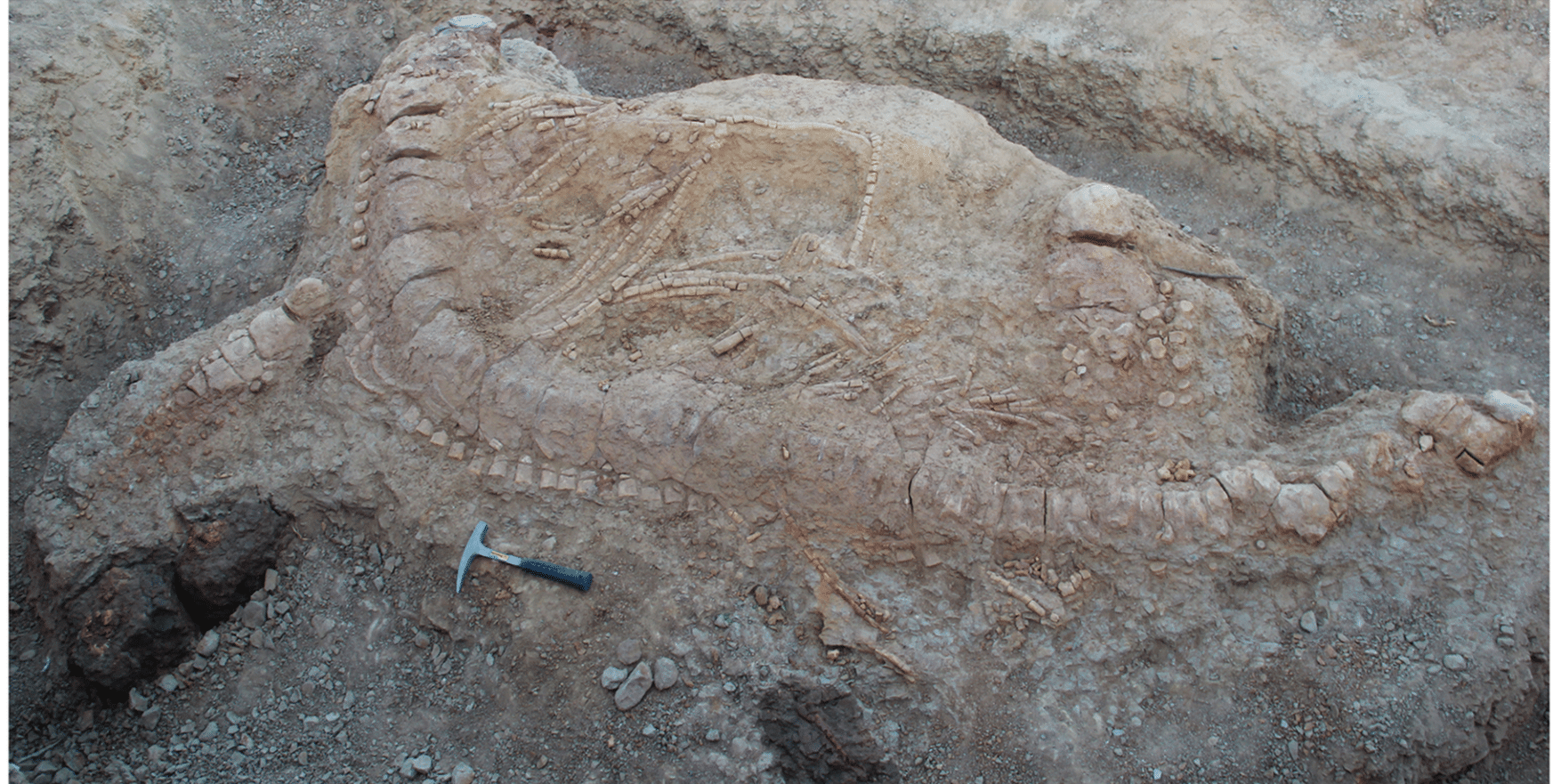Life
Scientists Discover First Jurassic-Era ‘Fish Lizard’ Fossil in India

Field photograph of the excavated ichthyosaur skeleton in Kachchh, India.
Guntupalli Prasad/ journals.plos.org
The discovery of the Ichthyosaurs fossil shows India's connect as part of Gondwanaland.
The discovery of a near-complete fossil of a Jurassic-period “fish lizard” from a village in Gujarat’s Kutch district is “the most significant Indian fossil record” and throws light on India’s biological connectivity with other continents during that period over 150 million years ago, says a scientist involved with the excavation.
The fossil of an ichthyosaur, literally “fish lizard” in Greek, was the first near-complete and articulated reptile found in India as all the previous fossils found were fragmented, small, non-complete and inarticulate.
The find also represented the first record from the Jurassic period (199.6 to 145.5 million years ago) in India as well as the Mesozoic era (between 250 and 65 million years).
“This is a remarkable discovery not only because it is the first Jurassic Ichthyosaur record from India, but it also throws light on the evolution and diversity of Ichthyosaurs in the Indo-Madagascan region of the former Gondwanaland and India’s biological connectivity with other continents in the Jurassic,” Guntupalli Prasad, a vertebrate paleontologist at University of Delhi and also lead researcher of a paper published in journal PLOS ONE, told IANS.
The fossil measured between 5.0 and 5.5 m in length and is thought to belong to the Ophthalmosauridae family, which likely lived between around 165 and 90 million years ago. The tooth wear patterns suggest that it preyed on hard-skinned animals.
“Our finding is significant because it is the first Ichthyosaur record from the Jurassic rocks of India as well as South Asia and it is also the only articulated nearly complete skeleton from the Mesozoic rocks of India,” Prasad said.
“Ichthyosaur is the most significant Indian fossil record and throws light on the vertebrate fauna — their evolution, changing latitudinal position and climatic zones — inhabiting the Indian plate during its northward journey during the Mesozoic era,” he said.
“When identified at genus and species level it may throw some new light on marine faunal interchanges between Europe, Indo-Madagascan bioprovince and South America,” Prasad said.
The research began with a field study in the Kas Hill area near Lodai village, 30 km northeast of Bhuj town, where the researchers found small fragmentary bones as well as an in-situ rib of the animal.
Following this, a full scale excavation of the skeleton took place, which was completed in 10 days over 1,500 man-hours assisted by Masters students from Krantiguru Shyamji Krishna Verma Kachchh and Delhi Universities.
The discovery has an important bearing on the diversity and evolution of Ichthyosaurs in the former southern super-continent Gondwanaland where these marine reptiles were believed to have scant presence as compared to their abundance in the Northern Hemisphere continents.
While many Ichthyosaur fossils have been found in North American and Europe, in the Southern Hemisphere, their fossil record has mostly been limited to South America and Australia.
Although India hosts extensive marine Jurassic deposits both in the Himalayan and peninsular Indian (Kutch, Jaisalmer) regions, until now no Ichthyosaur remains have been documented.
The discovery expands knowledge on morphological diversity and geographic distribution of Late Jurassic ophthalmosaurids, their dietary habits and palaeobiogeography, the scientist said.
During the excavation, Ichthyosaurs was found among fossils of ammonites and squid-like belemnites.
The vertebral column, ribs, neural spines, gastralia and two associated fins were found in articulation.
Additionally, a part of the snout representing the premaxilla was found at the anterior end of the preserved vertebral column and a few isolated teeth, vertebrae, jaw fragments, and other bone fragments were found scattered around the excavation site.
The skeleton is encased in a hard, ferruginous nodular matrix whereas the ribs are preserved in soft shale. The vertebral column preserved a portion of the cervical region, the entire dorsal region, and a part of the pre-flexural region and measures 3.6 m.
Taking into consideration its 36 cm long preserved premaxillary bone, missing skull region and the post-flexural vertebrae, it is inferred that the complete skeleton may have measured between 5 and 5.5 m in length.
The skeleton and two paddles were collected in six plaster jackets, before transporting it to the Kachchh University, where it is kept on display for general public, the scientist said.
Prasad told IANS, that it is clear from the finding that Jurassic rocks of Kutch hold great potential for articulated skeletons of marine reptiles, and that the research team is preparing for more exploration in the Kutch mainland, island belt and surrounding hills.
Besides, they also plan to undertake an intensive search for marine vertebrate fossils in Jurassic sedimentary rocks of this region as well as other marine basins such as Jaisalmer Basin in Rajasthan and Spiti in Himachal Pradesh. — (IANS)
2 Comments
You must be logged in to post a comment Login

Pingback: Scientists Discover First Jurassic-Era ‘Fish Lizard’ Fossil in India – Michael Jackson
Pingback: Jurassic Ichtyhosaur Fossil Found In India For The First Time – Michael Jackson